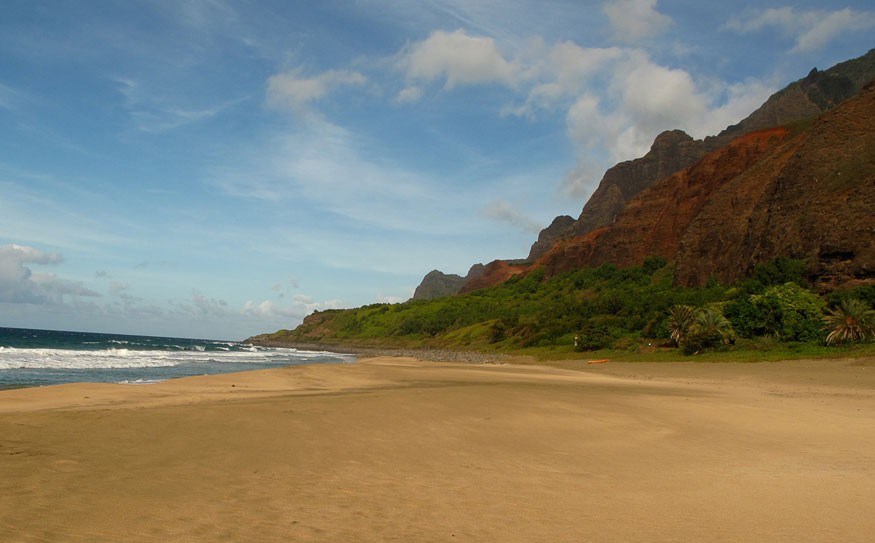Upon first glance of Kalalau valley, our first instinct was to head straight to the beach. While visible from our vantage point rounding the corner at one of the valley's bookends, the descent to reach the water's edge took over 45 minutes. The valley itself is vast, but you can navigate around within it in a day or two.
Two hundred years ago, before white settlers took over the island, thousands of native Hawaiians called this valley home. The evidence pervades the valley, with original terracing structures and religious sites still intact. However, these structures are increasingly threatened by the powerful root system of the invasive trees planted by the settlers, Haole.
At the valley's trough sits a creek that you must cross in order to get to the beach. When we crossed it in the dry season it seemed innocuous enough, but judging by the lack of vegetation on the steep banks, it's clear the creek can move much more furiously. Further inquiry with a local Hawaiian led to stories about tourists who set up camp next to the stream. By morning there was no trace of them thanks to a flash flood from the rainforest highlands. It may or may not be a rumour, but it affirms the fact that this is truly a wild valley where respect for the land is essential to assure survival.
Many tiring hours and 24 kilometres after beginning our journey we arrived at Kalalau beach. To describe the setting in words is nearly impossible, as any account will be but a very narrow glimpse of the grandeur that enveloped our entire being. Energetically speaking, the beach felt as though it was alive — as if it were radiating a vibration from deep below. It could have just been the effect of the late afternoon sun reflecting off the ocean and onto the surrounding amphitheatre of "Na Pali." But I was advised of this energy by locals before the trip, and I in turn will advise others — you must feel it to truly believe it.
The beach was an ideal point to relax and decompress after a long, strenuous journey. The view of the sun disappearing behind the horizon will forever be imprinted into the memory of everyone lucky enough to witness the scene. The one and only legal campsite in the valley lies directly behind the sandy shoreline, right at the point the vegetation begins. Camping permits are only good for a maximum of five days, but the size and complexity of some of the camps implied that this limit had not been enforced for some time. Had we known the splendour and peace the valley brings to those who visit we would have packed for a longer visit as well.
While touring the valley we encountered several "locals" camped out throughout the highlands. All the camps we stumbled upon were incredibly basic with only a few "First World" amenities such as books and percolators to keep sanity on an even keel. One squatter, Frankie, had a long beard and demeanour of someone who did not spend much time interacting with others. Yet he spoke of secret orchards and gathering points where locals would come together in a central area, as any other group gathers on certain nights in celebration and communion. Goats and pigs were introduced decades ago, and now provide ample sustenance for those who wish to feed themselves without need for outside contact.
One of the only signs posted in the valley was a carving on a board with the words "big pool." Seeing as we had nothing better to do than explore the valley, the sign was enough to commence an exploration. The trail to the Big Pool sometimes disappeared, or became a riverbed for a few dozen metres, but somehow we always found our way back on a trail and eventually found the pool. Despite our near-tropical latitude, the water in the pool was cool and refreshing, as it originated 1,200 metres above as rainwater only hours earlier. The water temperature was a welcome surprise and provided relief from the hot sun above.
Kalalau is a place that will relax you more than any spa, challenge your willpower to reach it, and reward you with the realization that few westerners have set foot in this valley. In a world where it is difficult to escape tourist traps and commercialization, it is refreshing to visit a place in Hawaii that provides something else for a holiday. While relatively close in distance to civilization, Kalalau helps to align those who visit with a sense of what it means to be a part of nature — hopefully for endless generations to come.




